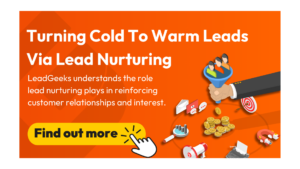Qualifying leads is crucial in sales and marketing. It’s like separating stones from gemstones. Here’s an easy guide to help you find the best potential buyers, making your sales efforts go further.
Why Is Qualifying Leads Important?
Focusing on the right leads saves you time and improves your success rate. It ensures you engage with people more likely to buy, streamlining your sales process.
Impact of Qualifying Leads on Your Business
-
Reduced Wasted Time: Focus on prospects with budget, authority, and need (BANT criteria).
-
Higher Win Rates: Prioritize leads aligned with your Ideal Customer Profile (ICP).
-
Improved Forecasting: Predict pipeline health with accuracy.
5 Steps for Finding Top Leads
Define Ideal Leads
Start by listing traits that make someone a good lead for you. Consider their job, past interactions with your brand, and other key factors. This helps you quickly identify who’s worth your time. Create a detailed ICP (Ideal Customer Profile) to identify prospects most likely to convert and deliver long-term value.
Key Criteria in Defining Ideal Leads
- Firmographics: Industry, company size, revenue.
- Technographics: Existing software/tools (e.g., labs using legacy LIMS systems).
- Behavioral Signals: Content downloads, webinar attendance, pricing page visits.
- Psychographics: Goals (e.g., faster drug discovery), challenges (e.g., compliance risks).
Score Your Leads
Assign points for various actions a lead might take, like signing up for a newsletter or attending a webinar. High-scoring leads are more promising and should be contacted first.
Scoring Model Example
- Demographic Fit: +20 points (e.g., matches ICP).
- Website Engagement: +10 points for visiting pricing page 3x.
- Content Interaction: +15 points for downloading a case study.
- Negative Scores: -10 points for unsubscribes.
Categorize Lead Readiness
Sort your leads by their readiness to buy. Categorize them as ‘hot’, ‘warm’, or ‘cold’. This way, you can tailor your approach, focusing immediate efforts on ‘hot’ leads while nurturing ‘cold’ ones.
Criteria for Segmentation:
- Hot: Fits ICP, engaged with sales team, requested demo.
- Warm: Downloaded content but hasn’t engaged sales.
- Cold: Visited website once, no recent activity.
Make Nurturing Tactics by Category
-
Hot Leads: Immediate 1:1 outreach (e.g., personalized demo).
-
Warm Leads: Nurture with email sequences and retargeting ads.
-
Cold Leads: Drip campaigns with educational content.
Select the Best Communication Method
Not everyone prefers the same form of communication. Some might respond better to emails, others to phone calls. Adapting your approach can lead to better interactions. Match outreach channels to lead preferences and behavior.
Communication Channels You Could Use
- Email: Ideal for sharing case studies or ROI calculators.
- Phone: Best for hot leads who requested urgent follow-up.
- LinkedIn InMail: Engage executives with personalized messages.
Review and Adapt
The effectiveness of lead qualification strategies can change over time. Regularly evaluate your approach and make adjustments to stay effective.
Monthly Audit Checklist:
- Are hot leads converting at expected rates?
- Which content assets drive the highest-quality leads?
- Are sales and marketing aligned on lead definitions?
The Value of Lead Qualification
By targeting the right leads, you not only make your sales process more efficient but also ensure a better use of your marketing resources. Every effort and investment contributes towards reaching leads that are much closer to making a purchase.
These straightforward steps can help simplify your sales process and result in a better sales outcome.
Want to learn more tips for your Business to Business strategies? Keep following our LeadGeeks for more easy-to-apply sales and marketing tips that can give you a competitive edge!














Leave a Reply